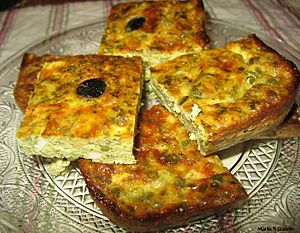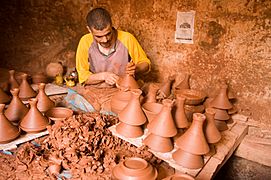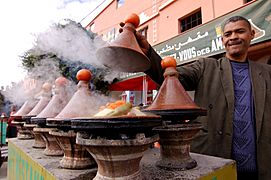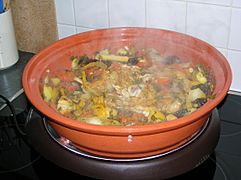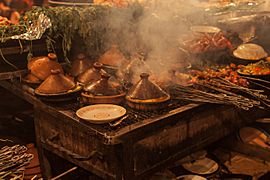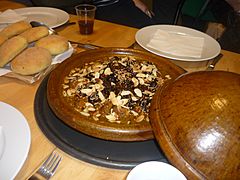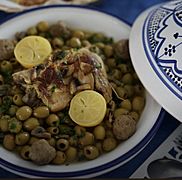Tajine facts for kids
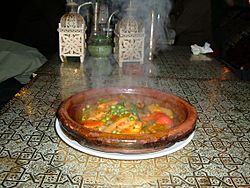
A vegetable tajine dish as served in a London restaurant
|
|
| Alternative names | Tagine |
|---|---|
| Type | Stew or casserole |
| Region or state | Maghreb |
| Associated national cuisine | |
A tajine or tagine (Arabic: طاجين) is a delicious North African dish. It's named after the special earthenware pot it's cooked in. People also call it maraq or marqa.
Contents
What's in a Name?
The word tajine comes from the Arabic word طجين (ṭažin). This word itself came from the Berber word ṭajin, which means 'shallow earthen pot'. Even older, it came from the Ancient Greek word τάγηνον (tágēnon), meaning 'frying-pan' or 'saucepan'.
Where Did Tajine Come From?
Some historians believe that cooking in a tajine-like pot goes way back in time. Pieces of old cooking pots, similar to modern tajines, have been found in places like Tunisia.
Many sources say the history of the tajine dish goes back to the time of Harun al-Rashid. He was a famous leader from the 9th century. The idea of cooking in a tajine even appears in the well-known story collection One Thousand and One Nights.
Today, the tajine pot and its traditional stews are mostly made in the Middle East and North Africa. There are different ways to prepare a tajine. One old way uses a special type of clarified butter called saman for flavor. Another way uses olive oil to make the flavors richer.
A food historian named Gil Marks says that the unique two-piece tajine pot, made from red clay, first came from Morocco.
Many old Arab scholars wrote about how to make a tajine. One famous description is from ibn al-Adim (who lived from 1192 to 1262). He wrote about boiling meat, frying it with spices and onions, and then adding other ingredients like fennel.
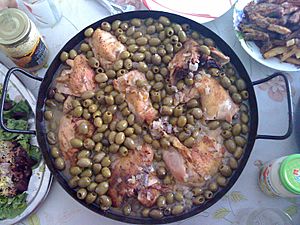
The Special Tajine Pot
The traditional tajine pottery has two main parts. It has a round, flat base with low sides. On top of this base sits a large, cone-shaped or dome-shaped lid. This lid is designed to trap all the steam during cooking. This steam then turns back into liquid and drips down into the food. This helps keep the food moist and flavorful. You can even add cold water to a special well on top of the lid to make this process work even better.
Tajine is traditionally cooked over hot charcoal. People leave enough space between the coals and the pot so the heat doesn't get too high too fast. Large charcoal bricks are used because they stay hot for many hours. You can also cook tajine in a slow oven or on a gas or electric stove. When using a stove, a diffuser is often placed between the pot and the flame. This helps spread the heat evenly. Some modern tajines have heavy cast-iron bottoms. These can be heated to a high temperature, which is good for browning meat and vegetables before slow cooking.
You can try to cook a similar dish in a slow cooker, but it might not taste exactly the same. Many ceramic tajine pots are also used as beautiful decorations, not just for cooking. However, some tajines are only made for serving food, not for cooking in.
Algerian and Moroccan Tajine Dishes
In Algeria and Morocco, tajine dishes are usually savory stews cooked slowly. They often have sliced meat, chicken, or fish mixed with vegetables or fruit. Spices, nuts, and dried fruits are also common ingredients. Popular spices include ginger, cumin, turmeric, cinnamon, and saffron. For vegetable tajines, paprika and chili are often used. A mix of sweet and sour flavors is common, like lamb with prunes and spices. Tajines are usually served with bread.
Because the special lid traps steam and returns the liquid to the pot, you don't need much water to cook the meat and vegetables. This cooking method is very helpful in places where water is scarce.
Tunisian Tajine Dishes
What Tunisians call a "tajine" is quite different from the stews found in other countries. Tunisian tajine is more like a thick frittata or an eggah (a type of omelet).
First, a simple stew is made with very small pieces of meat, cooked with onions and spices. Common spices include a mix of dried rosebuds and cinnamon, or a strong blend of ground coriander and caraway seeds. Then, something starchy is added to make the sauce thicker. This could be cannellini beans, chickpeas, breadcrumbs, or cubed potatoes.
Once the meat is tender, it's mixed with other ingredients that give the dish its main flavor. These can be fresh parsley, dried mint, saffron, sun-dried tomatoes, cooked vegetables, or even cooked calves' brains. Next, cheese and eggs are added to make the stew richer. Finally, this egg and stew mixture is baked in a deep dish, either on the stove or in the oven. It's cooked until the top and bottom are crispy and the eggs are just set. When it's ready, it's flipped out onto a plate and cut into squares, often served with lemon wedges. Tunisian tajines can also be made with seafood or be completely vegetarian.
In some rural parts of Tunisia, people cook tajine by placing an earthenware dish over olive-wood coals. They fill it, cover it with a flat earthenware pan, and then pile hot coals on top. This way, the tajine gets a crispy top and bottom, stays moist inside, and has a lovely smoky smell.
Maghrebi Jewish Tagine
Maghrebi Jews also eat and prepare tagine. This is because Jewish communities have lived in North Africa for a very long time. Tagine is a very important dish in Sephardi cuisine. It is often eaten by Moroccan Jews, Algerian Jews, Tunisian Jews, Libyan Jews, and others. It's also popular among French Jews, Jewish Americans, and Israelis because many Sephardic Jews live in those countries.
Tagine is a main dish for Shabbat dinners in the Sephardic community, often served with couscous. Sephardic Jews from different regions make different styles of Tagine. For example, Moroccan Jews often make tagine with dried fruits. Tunisian Jews often make a vegetable tagine with potatoes, carrots, and zucchini cut into large cubes. Tagine is also commonly prepared for Jewish holidays like Rosh Hashanah and the Yom Kippur break fast.
Gallery
See also
 In Spanish: Tayín para niños
In Spanish: Tayín para niños



